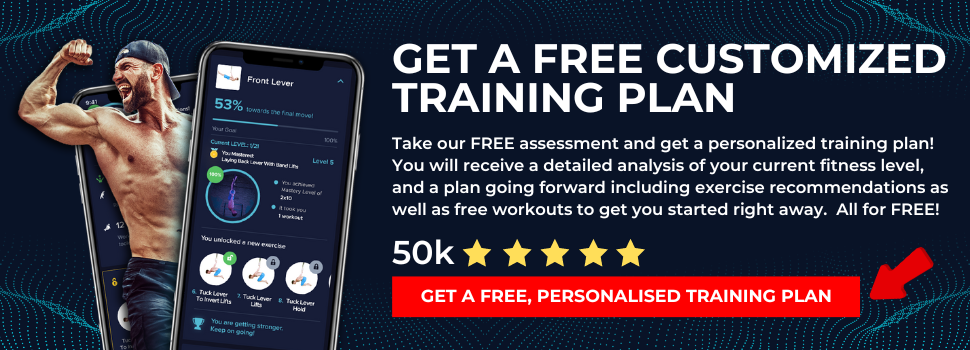Mastering the Basics of Calisthenics: Your Training Plan and Workout Blueprint
Have you ever watched in awe as a calisthenics athlete seemingly defied gravity with their fluid body motions, all while sculpting muscles to Greek godlike standards? You might be thinking, “That could be me!” Well, the good news is that it absolutely could be – with the right information and plenty of determined practice and patience.
Calisthenics, which comes from the Greek words ‘kallos,’ meaning beauty, and ‘sthenos,’ meaning strength, is all about using your body weight to build strength and flexibility. It’s a form of exercise that is both timeless and incredibly rewarding, as it empowers you with tools—not just muscles, but a deeper understanding of your body and its capabilities.
For those who are new to this type of exercise, understanding the foundations is crucial for injury prevention and overall progress.
Before we jump into handing you those killer workouts that’ll have you doing handstands and muscle-ups like it’s nobody’s business, we need to chat about something super important – the principles of creating an effective calisthenics training plan. Trust me, grabbing these concepts now will save you a ton of time (and maybe a little bit of ego) in the long run. It’s not just about doing random exercises until you’re tired; it’s about strategically building a routine that progresses with you, challenges you, and most importantly, keeps you injury-free. So, buckle up! We’re about to get into the nitty-gritty of putting together a plan that’s as smart as it is hard-hitting.
So buckle up – we’re about to lay the groundwork for your calisthenics revolution.
What we have learnt from over a decade and training hundreds of people with progressive calisthenics:
Personalized Training: Tailoring Success One Athlete at a Time
Back in the day, our team was deep in the trenches of in-person calisthenics training. We were on a mission to figure out the most effective way to level up our clients’ game. It hit us like a ton of bricks that a one-size-fits-all workout regimen just wasn’t cutting it. What really made the difference was this super tailored approach — not just tossing folks into beginner, intermediate, or advanced buckets, but getting right down to the nitty-gritty of where each person stood on their fitness journey.
We went all mad scientist, constantly tweaking and experimenting with different progressions to see what clicked. Autoregulation became our best friend. By adjusting reps and sets on the fly, we could guide our clients through their workouts with laser precision. And, oh man, when we got a solid assessment protocol in place, it was game-changing. We could pinpoint exactly where someone’s strength and mobility were at, and tailor their exercises so precisely, it was like we had a magic wand.
Now, why am I harping on about customization? Well, because sticking to those generic workout levels might actually be holding you back. Seriously. Here’s the deal: Clumping everyone together can lead to all kinds of issues, from promoting bad movement habits to risking injuries if things are too tough, or not pushing enough for real growth if it’s too easy.
But here’s the kicker — personalizing workouts is hard, like, really hard. Trying to concoct a perfect training cocktail for every individual in a group setting? Nearly impossible without cloning yourself. That’s where technology swings in like a hero. We dreamed up The Movement Athlete — a platform where personalization isn’t just a fancy buzzword; it’s the essence of what we do. We’ve poured everything we’ve learned from training hundreds of athletes into an app that crafts a workout as unique as you are. It was a beast of a project, but boy, was it worth it. Now, we’ve got a thriving tribe of over 5,000 members, thousands of exercises, and a platform that’s all about taking you on a bespoke fitness adventure. There’s nothing else out there quite like it.
So, if you want to jump right in and skip those cookie-cutter workouts, and experience the power of personalization for yourself, take our free assessment. No credit card required, it’s completely free! It’ll only take 5 minutes, and we’ll give you a personalized training plan just for you. You’ll be able to see where you are on your journey towards mastering calisthenics movements and get a clear path forward. Again, it’s completely free. What have you got to lose?
Ok, now that we got this out of the way, let us share with you a few more things you should know about calisthenics and calisthenics workouts.
The Calisthenics Philosophy
What is Calisthenics, Anyway?
Calisthenics is more than just a workout routine; it’s a lifestyle that promotes functional strength and an active, healthy body. Unlike weightlifting—the practices it’s often compared to—calisthenics is about relative strength, which means you’re not striving to bench press a set amount. Instead, you’re focused on exercises that manipulate your body through space, like pull-ups, push-ups, and dips.
The Key Principles
At its core, calisthenics is about doing more with less. No heavy equipment or machines, just you and the fun challenge of combining strength, balance, and control.
Progressive Overload: The centerpiece of any workout plan, calisthenics or otherwise. You have to make exercises tougher over time to grow stronger.
Full-Body Movements: Where isolation exercises like bicep curls focus on one muscle group, calisthenics exercises demand a full-body commitment.
Balance: Calisthenics workouts should balance pushing and pulling movements, as well as engaging the core.
Control: Every rep should be done deliberately, with the goal of maintaining control throughout the entire range of motion.
But these are not enough.
We see most calisthenics programs making these 3 mistakes
Avoid these 3 mistakes of calisthenics workouts
Problem #1: Most Calisthenics Systems are Too Random for You to Make Progress
If you’ve dabbled with some of the apps out there, you’ve seen it firsthand: they tend to throw random workouts at you. This might seem okay if you’re just dipping your toes into fitness without a clue where to begin. But here’s the deal: Most of us have been active for quite some time. We’re past the point where doing just anything will lead us to tangible results. Meaning, random workouts lead to zero progress. It’s like wandering without a map, not really hitting any milestones or achieving your goals. Understandably, that’s super frustrating.
“You can get a bit of help through YouTube videos and all of that, but it’s not the same. And I just wanted something more. I found TMA, and I thought might as well try. – William Hayman, 33, Counselor, Therapist”
“I used Freeletics and Kernwerk before. With both of them, I had the greatest problems with the duration of the workouts, which I couldn’t adjust. I also felt a lack of variation and long-term motivation. The holistic approach and this ‘working towards a certain skill’ slowly progressing but knowing ‘what the effort is for’ feels much more motivating.” – Jelka, 33, Office Worker”
“I used Madbarz for a long time, but it’s so rigid in moves and reps. I did not make any progress, instead, I got myself an injury by trying exercises that were too hard for me.” – Symon, 42
What You Really Need: A Customized Plan
Instead of surrendering your fitness goals to the chaos of random workouts, what you truly need is a structured, tailor-made calisthenics program. Imagine a plan that’s specifically designed around your current fitness level, your specific goals, and the skills you’re itching to master. A program that grows with you, becoming more challenging in a structured manner, ensuring that every rep brings you one step closer to your goals. A customizable training plan means you’re not just working out; you’re building a routine that’s uniquely yours. It’s about turning those random exercises into a coherent roadmap that leads to success.
“People progress at different rates, and a one-size-fits-all approach just doesn’t cut it,” says Jamie, a 29-year-old software developer who found his stride in calisthenics after ditching randomized workouts. “Having a plan that’s crafted for me means I’m not just doing push-ups and pull-ups randomly. I know each session brings me closer to nailing that handstand or muscle-up.”
This personalized approach not only boosts your motivation but also drastically reduces the risk of injuries. No more guessing games or pushing beyond your limits before you’re ready. With a plan that’s tuned to your abilities, you’ll build strength, skill, and confidence at a pace that’s right for you.
Problem #2: Most Calisthenics Programs are “Cookie-Cutter” and Not Customized to You
Let’s be real for a sec – who do you think is going to see the gains faster? Someone who’s stuck on the same ol’ generic plan as every Tom, Dick, and Harry? A plan with zero customization, no personal touch, and absolutely no guidance? Or someone who’s got a program tailored just for them, fitting their needs like a glove? The answer’s a no-brainer. It’s like the difference between reading a diet plan in a magazine versus having a nutritionist planning your meals. Without that personal touch, you might find yourself going too hard on days your body’s crying for rest, or slacking when you’ve actually got the juice to push harder. And honestly, without someone in your corner, guiding you every step of the way, you’re probably not going to hit your full potential.
What You Need: A System That Adapts to You and Guides You
Imagine this: You’ve had a tough day. You’re feeling super tired. However, you’re committed, and like the champion you are, you start your calisthenics session. Picture a personal trainer who can tell you’re not at your best today. Instead of sticking rigidly to the plan, they adjust, making sure your workout is challenging yet achievable, given how you’re feeling. You still get a solid session in, fueling your sense of accomplishment and keeping you pumped for the next workout. Because this system gets you: on days you’re ready to crush it, it pushes you harder; on days you need something lighter, it adapts. This kind of flexibility makes you actually look forward to your workouts.
“Using the app, it just gives me more motivation. It actually made me want to go back to the gym and go over lots of times.” – Enilson Andrade, 41, Computer Programmer
“The Movement Athlete is a must-try, because it caters to you, to each and every person’s individual skills. It’s like investing in your own body, you know what I mean?” – William Hayman, 33, Counselor, Therapist
“The Movement Athlete is the app that I would recommend first. This algorithm behind it basically adjusts your reps and also the exercises that you’re doing.” – Nicholas, 27, Project Manager
Now add problem number 3:
Problem #3: Most Calisthenics Systems Have Too Big of a “Jump” Between Progressions – So You Get Stuck
You know what’s super annoying? Getting all hyped because you’ve mastered one progression, only for your calisthenics program to throw you a curveball. The next step feels like climbing Mount Everest in flip-flops—practically impossible and kinda dangerous. Suddenly, you’re stuck, spinning your wheels and not making any headway. It’s beyond frustrating.
“I’ve tried a few other bodyweight apps, but they sort of left you to make it up as you go along. No structure, just some random routines,” says Edward, a 40-year-old gas rig operator, echoing the sentiment of many. “The other apps at some point were just too hard. The steps they were taking were just too big. It was just super unrealistic, very.” This gap in progression isn’t just demotivating; it’s a fast track to feeling like giving up or, worse, to injuries.
What You Need: TONS OF “MICRO-PROGRESSIONS” SO YOU CONTINUALLY LEARN NEW MOVES
Have you ever heard the story of Goldilocks and the three bears? To sum it up: You need to have training that’s at the right level for you. If your progressions are too easy, you’ll get bored, and won’t make progress. If your progressions are too hard, you might get stuck, or injured. But if your progressions are consistently at that “just right” level… You’ll always be pleasantly challenged, you’ll make rapid progress – And you’ll have FUN! Because you’ll be constantly “unlocking” new skills. Which feels awesome. In order to make that happen, you need a calisthenics system with TONS of little “micro-progressions”. So you’re always using the exact right progression for YOU.
“The Movement Athlete app has built-in algorithms in the AI to help you progress when you’re ready to progress as long as you’re honest with it.” – Anthony Monte, 37, Airline Pilot
“The Movement Athlete really is a rewards-based system as well as so you’re not getting bored doing the same thing day in, day out every day. But also, you don’t rush in and hurt yourself.” – Edward, 40, Gas Rig Operator
“With The Movement Athlete, I don’t need to worry about getting stuck. It’s adaptive and fun.” – Jan Erik, Product Developer
ok, one more thing before we move onto creating your perfect workout
Autoregulation: Listen to Your Body
In the world of calisthenics, or honestly any form of training, your body’s feedback should be your ultimate guide. This is where Autoregulation comes into play, a fancy term for what can be summed up as “listening to your body.” Imagine you’re gearing up for today’s workout. Instead of blindly following a strict regimen of X sets and Y reps, you adjust on the fly. After pumping out a few pull-ups or deep squats, you ask yourself, “How tough was that on a scale of 1 to 10?” This self-assessment tool, often called Rate of Perceived Exertion (RPE), helps you customize your workout intensity based on how you’re feeling right now.
Why does this matter? Because some days you’re Superman, and other days, well, you’re not. On those not-so-super days, pushing yourself too hard can lead to burnout or injury, while going too easy on your super days means missed opportunities for growth. Autoregulation teaches you to tune in to what your body’s saying, making your workouts smarter and safer. It’s like your body is whispering its training needs, and you’re actually listening. Rather than getting frustrated over a plateau, you’ll learn to roll with it, understanding that progress isn’t always a straight line. It’s about encouraging yourself to stay the course, knowing when to push, and when to ease up.
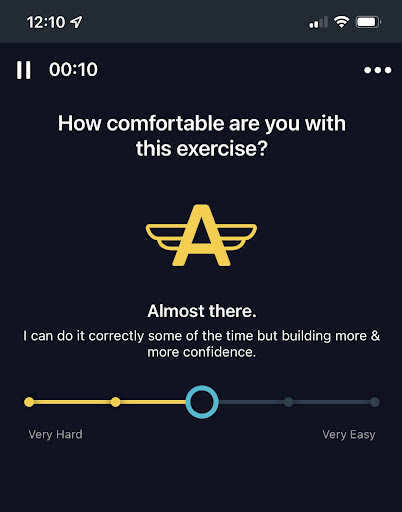
tma assessment
Creating the Perfect Calisthenics Workout
STEP 1. What exercises you should? The 9 calisthenics fundamentals
No calisthenics workout is complete without these seven fundamental exercises:
The Core of Calisthenics: 9 Essential Moves 😎
Alright, folks, welcome to the crux of the matter – the nine foundational exercises that no calisthenics routine should be without. Here’s the lowdown:
- Push-ups – These bad boys are your bread and butter for horizontal pushing strength. They work your chest, shoulders, and triceps like nobody’s business.
- Dips – Think of dips as the push-up’s vertical cousin. They hit the same muscle groups but switch up the movement pattern for comprehensive development.
- Pull-ups – The ultimate test of pull strength that targets your back, biceps, and gives your core a solid workout. Though primarily a vertical pull exercise, mastering pull-ups starts with nailing those horizontal pulls.
- Squats – Lower body powerhouse move. Squats are all about building strength in those legs and enhancing joint mobility down below.
- Handstand – More than just a party trick, the handstand is a fundamental skill in calisthenics. It bolsters shoulder strength, wrists, straight-arm prowess, and core stability, all while laying the groundwork for more advanced moves.
- Body Line Training – This one’s all about core strength in the anti-extension department, a critical component for a myriad of other calisthenics exercises.
- Abs Training – Everyone’s favorite or not-so-favorite. While sculpted abs depend largely on your diet, training this area is crucial for core development.
- Sides – This exercise puts the spotlight on your obliques, adding that much-needed emphasis on the sides of your core.
- Back – Last but definitely not least, training your lower back rounds out your core work, ensuring a balanced, strong foundation.
And there you have it! These nine fundamentals are your stepping stones to a solid calisthenics practice. Nail these, and you’re well on your way to building strength, skill, and a body that’s as functional as it is aesthetic.
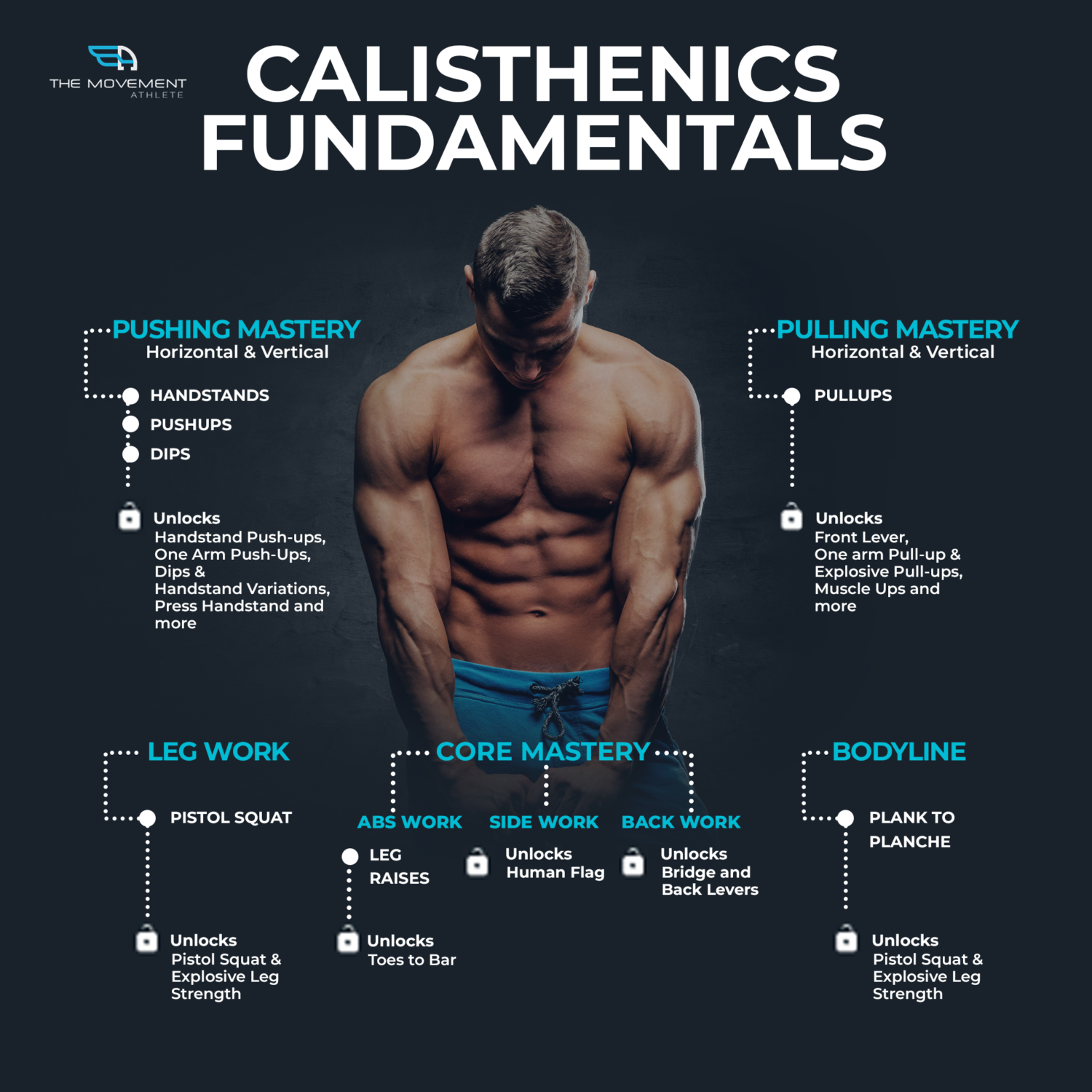
Calisthenics Fundamentals
Beyond Fundamentals: Advanced Calisthenics Moves
Hey there! Now, for those of you who are confidently knocking out those foundational moves, you might be itching for a bit more challenge. It’s super important to keep pushing the envelope, not just for the gains, but for the thrill of mastering something new. Remember, without assessing where you’re at, you might miss out on tailoring your routine for max impact. Not sure where you stand? No problemo! Consider taking our free assessment to pinpoint exactly which skills you should focus on next. Your training needs to hit that sweet spot – not too easy, not a Herculean task, but just right for you.
Here’s a sneak peek at some of the advanced skills you could be adding to your repertoire:
- Front Lever – A true test of core and upper body strength, pulling off a front lever is sure to impress.
- Planche – Not for the faint-hearted, the planche will challenge you to the core, literally and metaphorically.
- Muscle Up – Combine a pull-up with a dip, and bam, you’ve got the muscle-up. It’s a rite of passage in the calisthenics world.
- Human Flag – Hold yourself horizontal to the ground, defying gravity, and prepare for some serious oblique glory.
And that’s just the tip of the iceberg! Ready to see what else you could be working on? To view the full list of advanced skills and detailed guidance on how to tackle them, click here.
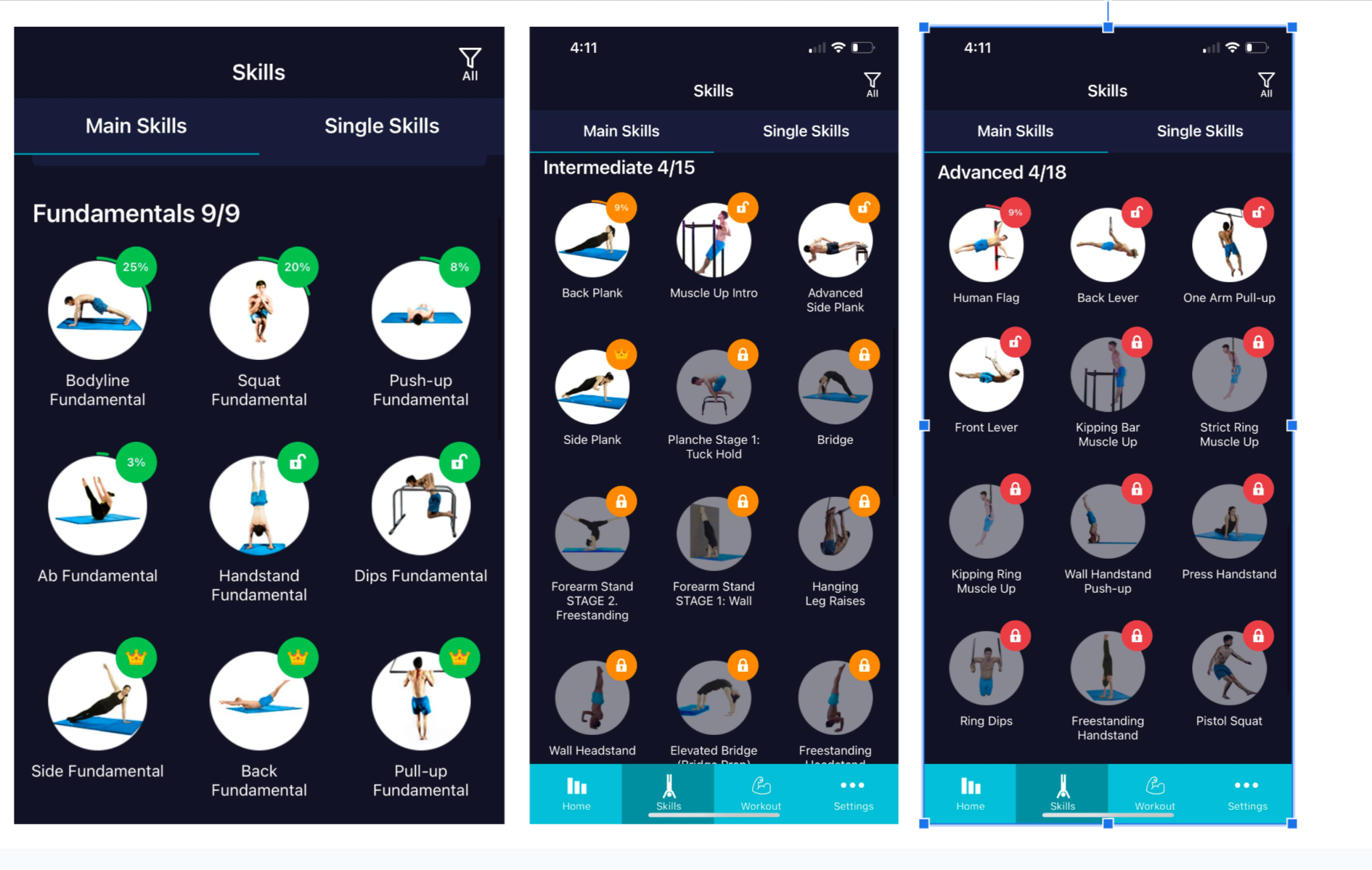
calisthenics skills movement athlete
Remember, the path to mastering advanced calisthenics is all about progression, patience, and persistence. And hey, have a little fun with it! There’s no better feeling than achieving something today that seemed impossible yesterday.
What are progressions and why they are critical to your workouts?
Progressions, my friends, are the heart and soul of calisthenics and the secret sauce to leveling up your game. Think of them as stepping stones tailored exactly to where you’re at—neither too daunting that you’re setting yourself up for a crash-land nor so easy that you’re cruising on autopilot. Progressions are your roadmap for creating that sweet spot of challenge, otherwise known as progressive overload, which is key to making each workout count. By dialing in on exercises that fit just right, you’re not only maximizing your gains but also minimizing the risk of injury. This way, every rep, every set becomes a building block towards achieving those loftier moves. In a nutshell, progressions ensure that every workout propels you forward, inching you closer to your fitness peak with a perfect blend of challenge and achievability.
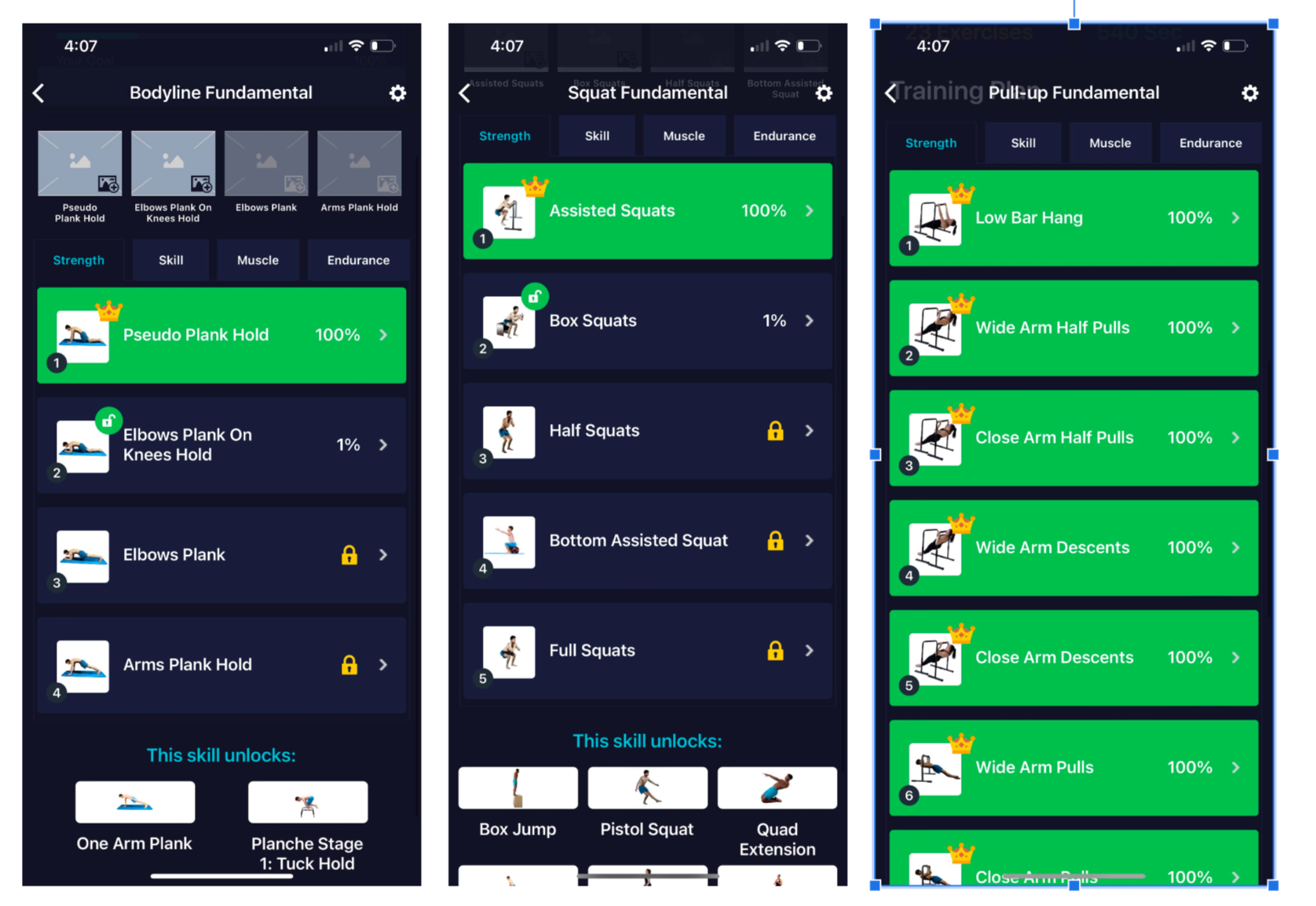
calisthenics progressions movement athlete
So to create an effective workout you need to know where exactly are you on a progression towards these skills. For example, there are 12 steps toward pull-up progression. Are you at the beginning, middle or almost can do a pull up/ the way to determine s is to ask yourself: Can i do a mastery level for eg Step 5: Close Arm Descents? (mastery level being a specific number of sets and reps eg 3×12).
You will see that you should NOT attempt some skills unless you mastered prerequisites for example:

calisthenics progressions
You can see progressions inside our app for free or go to a progression tab on this website.
To decide what exercise to include in your training plan, you simply assess yourself on every single progression and then include that exercise in your workout. Once you reach a mastery level for the exercise you are on, you can move to the next level, e.g., Step 6 of Pullup Progression.
If you follow this progressive way of training you will notice incredible benefits that are not otherwise visible if you are doing some random bodyweight workouts.
Incredible benefits of progressive bodyweight strength training done right
By training with nothing but your own body weight, you coax your body into naturally dropping fat while simultaneously gaining muscle and building real, functional strength. It’s the ultimate two-for-one deal in body transformation.
Transform Your Body 🚀
Craft an enviable physique that screams strength yet radiates leanness. Through calisthenics, achieve a muscular but proportionate build that showcases natural fitness at its peak.
Freedom to Train Anytime, Anywhere 🌍
Unlock the liberty to train whenever and wherever suits you best. Plus, you’ll become part of a supportive community of coaches and fellow athletes who are all in this together, ready to uplift and encourage at every step.
Help Prevent & Recover From Injuries 🛡️
One of the unique aspects of progressive calisthenics is its approach to training connective tissues and joints, significantly reducing the risk of injuries. It’s not just a workout regimen; it’s a recovery and prevention toolkit that many professional athletes swear by.
Strengthen Your Joints, Naturally 🦵
Progressive calisthenics uses your own body weight to foster strength in the most natural way possible. Your joints are designed for this. As you advance, they adapt without the danger of overwork or strain.
Develop Amazing Skills 🤸
While the ultimate goal is all-around, long-term fitness, sometimes it’s just fun to master some eye-catching, show-off moves. Thanks to meticulously designed progressions, pulling off awe-inspiring skills like the flag or handstand is well within your reach.
Dive into calisthenics, where every push-up, pull-up, and plank is a step towards a stronger, more vibrant you. It’s not just a workout; it’s a transformation both inside and out, with benefits that spill over into every aspect of your life.
What are the elements of An Effective Calisthenics workout
A truly effective calisthenics workout goes beyond mere personalization. It must also integrate a holistic approach, incorporating not only strength training but also mobility, flexibility, and balance. Calisthenics is unique in its complexity, requiring a comprehensive program that addresses all aspects of physical development.
Alright, here’s a bit of insider knowledge that really sets The Movement Athlete (TMA) apart on your fitness journey. But, guess what? The real magic doesn’t just happen in the planning; it’s all about how things unfold during those sweat sessions thanks to its standout structure. Ready for the scoop on why calisthenics is such a game-changer?💯 It boils down to its complexity. For example, you might have the strength to pull off a handstand, but if your shoulder flexibility isn’t up to par, holding that pose is a no-go. Plus, there’s all this skill stuff to think about. Take the handstand again; mastering your body alignment and knowing your entries and exits is crucial. And we can’t forget about endurance—it’s all about ramping up how long you can chill out on your hands. Then comes the muscle-building phase, beefing up those muscles to back up your mobility and make those ligaments strong.
Most programs out there? They won’t even touch on these elements. That’s where we do things differently. At TMA, your training gets crafted around these key areas, offering a well-rounded approach to your development.
Every time you fire up The Movement Athlete app for your daily grind, here’s what you’re in for:
- 💪Warmup + Mobility
- 💪Skill Work
- 💪Strength Work
- 💪Endurance Work
- 💪Muscle Building Work
- 💪Cooldown + Flexibility Work
This is the stuff that’s critical, yet no one’s talking about it.
Now, let’s break it down:
- ✨SKILL WORK: Technique is king in calisthenics. We’re talking movements that bring attention to specific techniques or train crucial movement patterns for what’s next. This involves low intensity and volume.
- ✨STRENGTH WORK: The beef of our program. These movements set your trajectory in the calisthenics realm, offering a wide range from easy peasy to bring-it-on, with reps and sets optimized for getting stronger.
- ✨MUSCLE WORK: A buff muscle can beef up into a stronger muscle. This part focuses on lower intensity and higher volume to really target those muscles, ensuring they’re engaged and growing.
- ✨ENDURANCE WORK: Calisthenics often involves holding your body in some intense poses. This phase boosts your ability to maintain those positions, with easier moves but more volume for ample practice time.
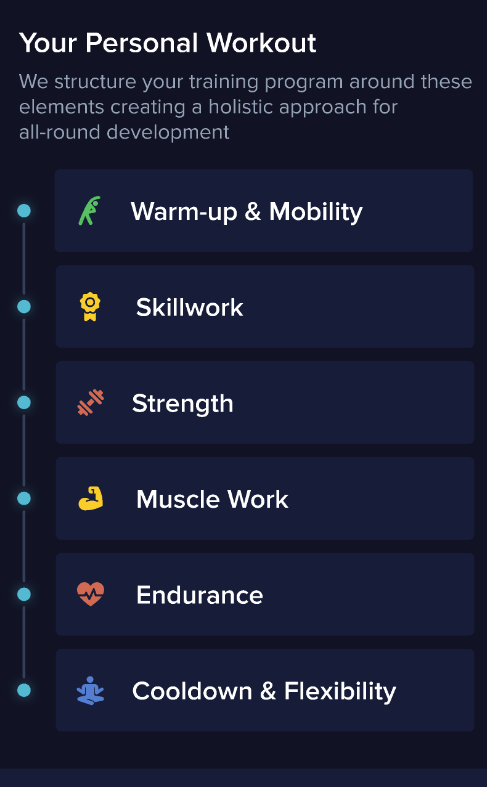
personalsied calisthenics training plan
By interweaving these diverse movement types, we’re crafting well-rounded, skilled, and mighty bodyweight athletes.
What exercises should go into my workout?
ok, now that you know what are the funda
👌 How many reps and sets should you use in your calisthenics workout?
When we yap about volume, it’s all about those reps and sets for each superhero move you pull. Reps? Think of them as your workout’s repeat telecast—how many times you crank out a move without taking a breather.
And sets?
Those are your binge-watch sessions—bundles of reps sprinkled with rest. Here’s the deal: if you wanna bulk up, think 8-12 reps; aiming for Hulk-like strength, muscle down on 1-6 reps. Dreaming about marathon muscles? Blast past those 12 reps.
And, for a golden middle ground, stick to 3-5 sets. Remember, pals, choosing the right villain to fight (I mean, exercise difficulty) is key to leveling up without just going through the motions.
👌How long should those rest periods be?
If you’re in the strength squad, chill out for 3 to 5 minutes. For the muscle-building crew, a 1 to 2-minute break will do. And endurance enthusiasts, just keep it short and sweet to keep the momentum.
👌How long should your calisthenics workout last?
Aim for a minimum of 30 mins to feel the burn and see the gains across your full body. Got more time? Stretch it to 90 minutes, warm-up and cooldown included. Short on time? Any workout beats no workout—keep it consistent, team.
How many days per week should you train?
Newbies, hit the full-body trifecta with three workouts per week—perfect for recovery and growth. Veterans can ramp up to 4-6 days with a split routine, just don’t forget that all-important rest day for recovery and skill upgrades.
👌How to record my progress?
—because if you’re not tracking, you’re slacking! Jot down every drop of sweat and every rep in a notebook or digital device. This isn’t just about recording; it’s about witnessing your transformation, identifying your kryptonite, and celebrating those small wins that lead to big victories.
Keep these steps in your back pocket, and you’re all set for a calisthenics routine that’s as dynamic as it is effective. Ready to transform?
If you are using our app even a free version, you won’t have to worry about this as the app tracks your workouts and progress and tells you exactly where you are:
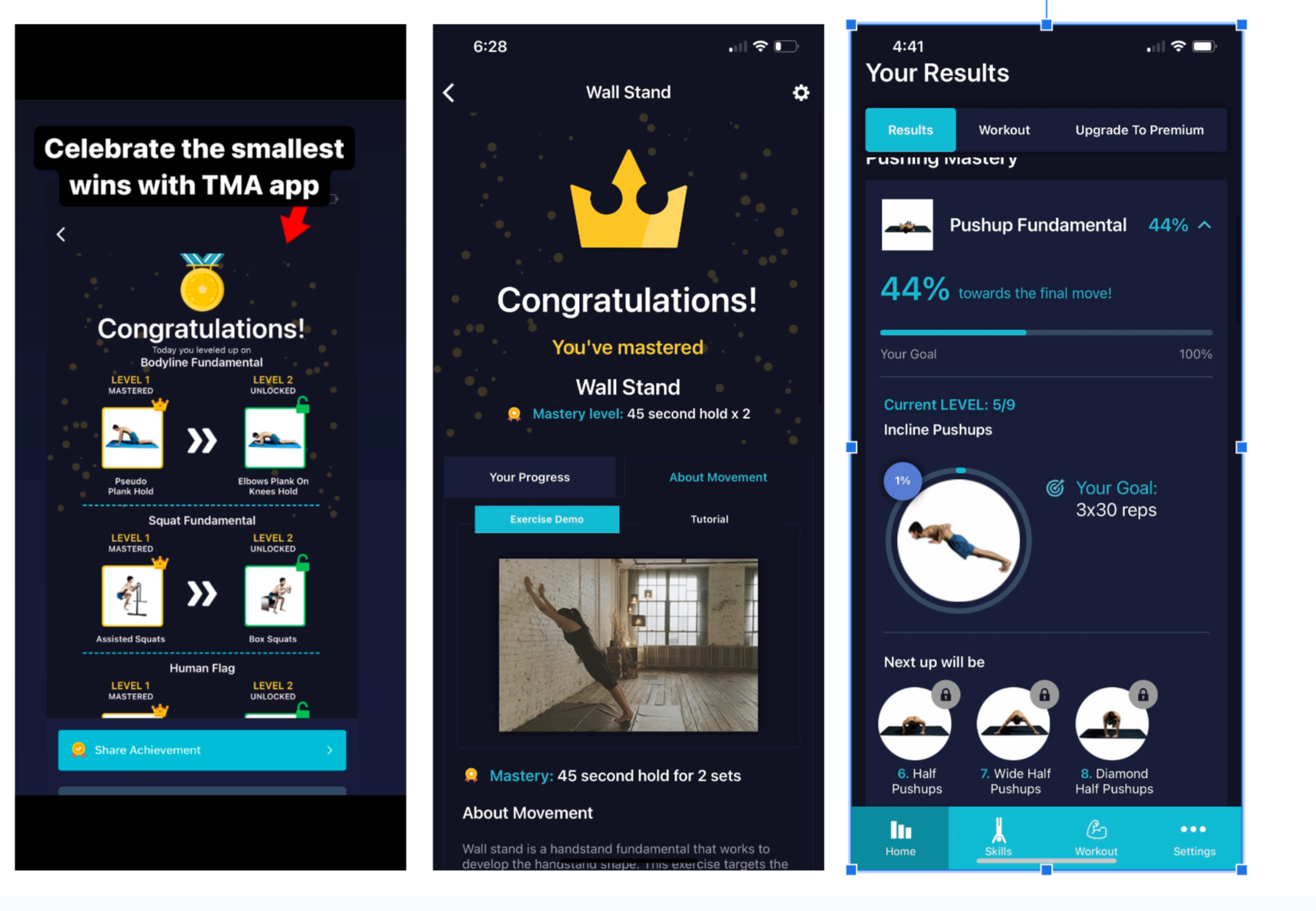
calisthenics training
Hundreds of calisthenics workouts to choose from.
With our app we encourage everyone to follow daily personalsied workouts, but there is a time where you would want to substitute that with ON DEMAND workouts or training plans. So we have ever-expanding library of stand-alone workouts and plans that you can do in your own time too.
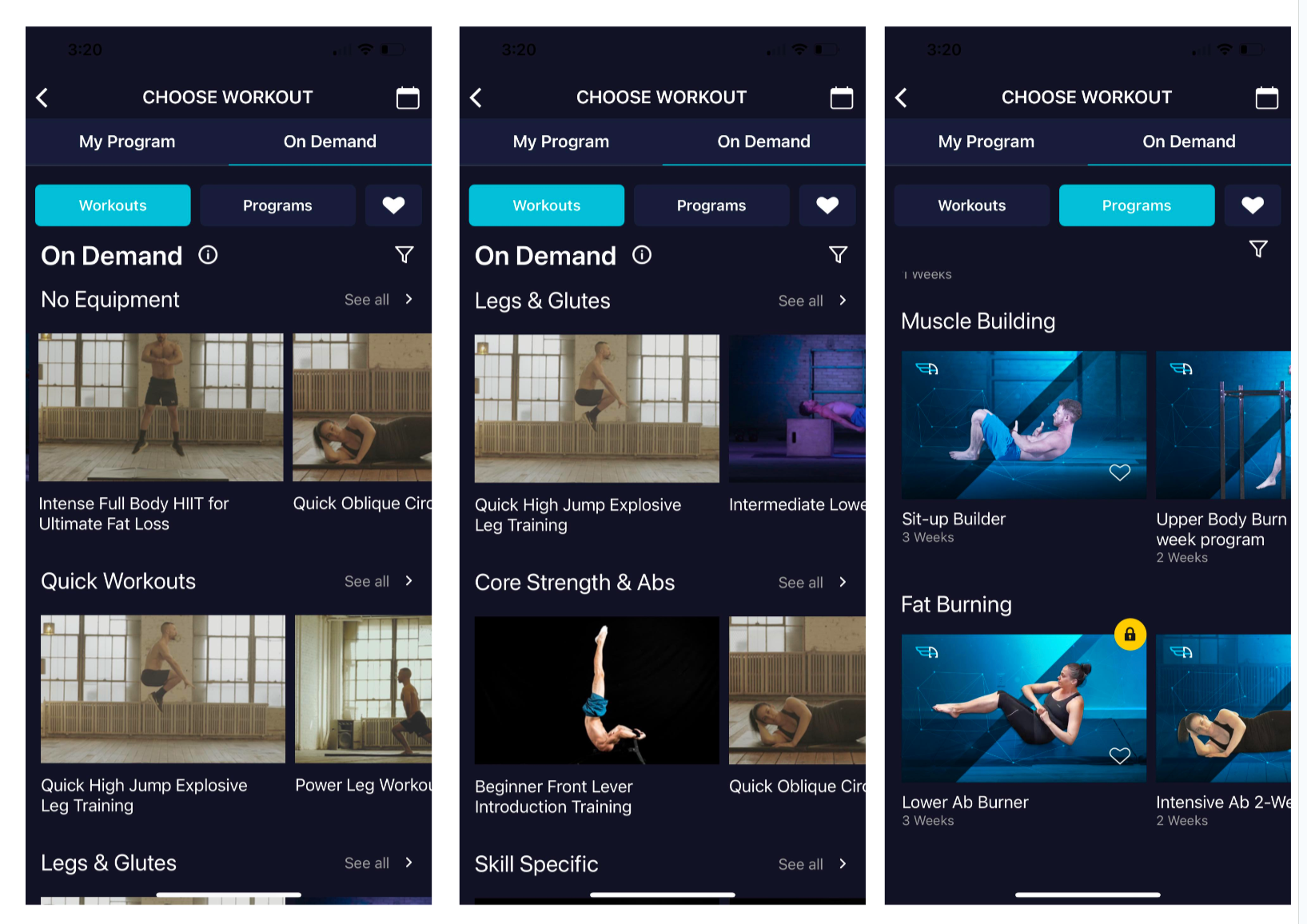
calisthenics workouts library
Where to go from there?
Calisthenics is accessible, adaptable, and requires minimal equipment – just your body. To be effective, it must be done correctly. Progressive calisthenics stands out as the most effective bodyweight strength training globally when its principles are followed, ensuring pain-free joints for life. It not only helps in getting lean but also provides functional strength and overall health. Avoid falling for pre-made routines or spending on expensive handstand courses. The Takeaway
Take advantage of our free assessment and receive a personalized training plan. It’s completely free, and there’s no pressure to upgrade unless you choose to. We’re excited to welcome you into our community and embark on this journey together to become stronger and leaner for life.

